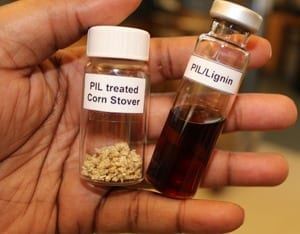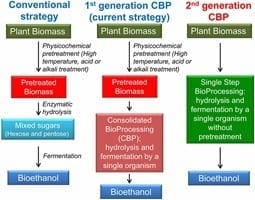
Researchers at North Carolina State University have developed a simple, effective and relatively inexpensive technique for removing lignin from the plant material used to make biofuels, which may drive down the cost of biofuel production.
Lignin, nature’s way of protecting plant cell walls, is difficult to break down or remove from plant materials called “biomass,” such as the non-edible parts of the corn plant. However, that lignin needs to be extracted in order to reach the energy-rich cellulose that is used to make biofuels.
“Finding inexpensive ways to remove lignin is one of the largest barriers to producing cost-effective biofuels,” says Ezinne Achinivu, a Ph.D. student in chemical and biomolecular engineering at NC State and lead author of a study describing the new technique. “And our approach is very promising.”
The researchers began by making a number of liquid salts called “protic ionic liquids” or PILs. These PILs are fairly inexpensive to prepare, because they are made by mixing together an acid, such as acetic acid (more commonly known as vinegar), and a base (a chemical class of materials called amines). As part of the pretreatment process, one of the PILs is mixed with biomass and then heated and stirred. The lignin dissolves into the PIL, leaving the cellulose behind as a solid. The cellulose, which is now much easier to process, is then easily filtered from the mixture for use in the next biofuel production steps.
The remaining PIL-lignin liquid mixture can then be heated to distill (or vaporize) the PIL, leaving the lignin behind as a black powder. The vapors from the PIL are collected and cooled to recover the liquid PIL so that it can be re-used. The lignin is also valuable, because it can be used to manufacture polymers or other chemical products which could supplement the cost of running the biofuel production facility.
“This PIL-based technique can be easily scaled up and is likely to be both more energy efficient and less expensive than existing biomass pretreatment techniques for removing lignin,” Achinivu says.
The Latest on: Biofuel production
[google_news title=”” keyword=”Biofuel production” num_posts=”10″ blurb_length=”0″ show_thumb=”left”]
via Google News
The Latest on: Biofuel production
- Feds give financial boost to biofuel sector amid growing U.S. competitionon April 28, 2024 at 1:00 am
Canada’s biofuel industry is welcoming a proposed multi-billion dollar package of financial support from the federal government, although concerns remain about whether it will be enough to compete ...
- Money Laundering Trial for Reputed CIA Asset and Turkish Tycoon Pushed — Againon April 27, 2024 at 12:16 am
Sezgin Baran Korkmaz, who counts James Woolsey (the former CIA Director under President Bill Clinton and advisor to former President Donald Trump) as a friend, was part of massive biofuel scam with ...
- Biofuel Scam Exposes Intrigue: CIA Ties, Turkish Tycoon and $1 Billion Fraudon April 26, 2024 at 7:38 pm
In what can only be described as a convoluted tale of international intrigue, a biofuel scam of monumental proportions has surfaced, involving an improbable assembly of individuals ranging from ...
- Solketal Industry Projected to Skyrocket to US$ 108.4 Billion by 2032, Fueled by Global Shift Towards Biofuelson April 26, 2024 at 8:29 am
The global solketal industry was worth US$ 76.85 Billion in the year 2022 and is expected to reach US$ 108.4 Billion by the year 2032 at a CAGR of 3.5% between 2022 and 2032. The solketal market is ...
- Researchers seek to scale ‘yeast fuel’ productionon April 26, 2024 at 7:34 am
Scientists at Thailand’s Chulalongkorn University say yeast and agricultural waste will play a key role in the development of renewable jet fuel for the aerospace industry ...
- Govt allows sugar mills to use 6.7 lakh tons of B-heavy molasses for ethanol production; here is how analysts view the moveon April 25, 2024 at 10:25 am
However, a week later, the government reversed the ban and allowed the use of cane juice and B-heavy molasses, but within the overall cap of a diversion of 17 lakh tonnes of sugar for ethanol ...
- Sugar Prices Slide as Conab Projects Record 2024/25 Sugar Production in Brazilon April 25, 2024 at 9:43 am
NY world sugar #11 (SBK24) this morning is down -0.32 (-1.60%), and Aug London ICE white sugar #5 (SWQ24) is down -8.30 (-1.44%). Sugar prices retreated today based on the outlook for a larger sugar ...
- Higher ethanol gasoline blend on sale in US for third summeron April 24, 2024 at 10:27 am
Last week, the EPA said that due to global conflicts pressuring international fuel supplies, it will allow a higher blend of ethanol to be sold in the U.S. for the third consecutive summer ...
- India lets oil firms procure extra ethanol from sugar mills, source sayson April 24, 2024 at 7:42 am
India has agreed to allow oil marketing companies to procure ethanol by diverting an extra 800,000 metric tons of sugar for biofuel production, a government source said on Wednesday.
- Govt allows sugar mills to use 6.7 lakh tons of B-heavy molasses for ethanol productionon April 24, 2024 at 6:55 am
The government has allowed sugar mills to use 6.7 lakh tonnes of B-heavy molasses as feedstock for ethanol production in the current year. The move follows the industry's request to the food ministry ...
via Bing News










